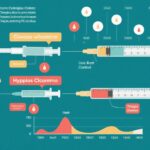Highlights
- Sarilumab, an IL-6 receptor antagonist, improves health-related quality of life and patient-reported outcomes (PROs) in relapsing polymyalgia rheumatica (PMR).
- Sarilumab significantly reduces cumulative glucocorticoid exposure and increases sustained remission rates compared to placebo.
- Patients with more severe disease derive the greatest benefit from sarilumab.
- Sarilumab’s safety profile includes increased rates of neutropenia and treatment discontinuation but remains manageable.
Clinical Background and Disease Burden
Polymyalgia rheumatica (PMR) is a common inflammatory disorder in older adults, characterized by pain and morning stiffness in the shoulder and pelvic girdles, often accompanied by elevated inflammatory markers (ESR and CRP). Glucocorticoids are the mainstay of therapy, rapidly alleviating symptoms. However, many patients experience disease flares during steroid tapering, leading to prolonged high-dose glucocorticoid exposure and associated morbidity (osteoporosis, diabetes, hypertension, infection).
There is a significant unmet need for effective steroid-sparing regimens in patients with relapsing or refractory PMR. Interleukin-6 (IL-6) is central to PMR pathogenesis, providing a rationale for IL-6 inhibition as a targeted treatment strategy.
Methodology
Two pivotal phase 3, double-blind, randomized controlled trials evaluated sarilumab in patients with relapsing PMR during glucocorticoid tapering:
– Patients aged 50 years or older, with a recent PMR flare during glucocorticoid taper (≥7.5 mg/day prednisone equivalent) and at least 8 weeks of prior steroid exposure (≥10 mg/day), were enrolled across 60 centers in 17 countries.
– Participants were randomized 1:1 to receive subcutaneous sarilumab 200 mg every 2 weeks with a 14-week glucocorticoid taper or placebo with a 52-week glucocorticoid taper. Patients and investigators were blinded to treatment allocation.
– Key endpoints included sustained remission at 52 weeks (defined as symptom resolution, CRP normalization, absence of flares, and adherence to taper) and a comprehensive set of PROs: Health Assessment Questionnaire Disability Index (HAQ-DI), Patient Global Assessment (VAS), Pain VAS, SF-36, EQ-5D, and FACIT-Fatigue.
– Intention-to-treat analysis was conducted, with follow-up to week 52 and post-hoc analyses for clinically meaningful improvements.
Key Findings
A total of 118 patients were randomized (60 sarilumab, 58 placebo); mean age was 68.9 years, and 69% were female.
Sustained Remission & Glucocorticoid Sparing:
– At 52 weeks, sustained remission was achieved in 28% of sarilumab-treated patients versus 10% in the placebo group (difference: 18 percentage points; 95% CI, 4–32; p=0.02).
– The median cumulative glucocorticoid dose was substantially lower with sarilumab (777 mg) than placebo (2044 mg; p<0.001), indicating a robust glucocorticoid-sparing effect.
Patient-Reported Outcomes:
– Sarilumab led to greater improvements in SF-36 Physical Component Summary (PCS) and Mental Component Summary (MCS) scores (PCS LSM change: 7.65 vs 2.87, p=0.020; MCS change: 3.04 vs -1.71, p=0.030).
– More than half of sarilumab-treated patients achieved SF-36 MCS and four domain scores at or above population norms, outperforming the placebo group.
– Additional benefits were seen in EQ-5D utility index (0.11 vs -0.02, p=0.034), HAQ-DI (-0.39 vs -0.15, p=0.054), and FACIT-Fatigue (7.91 vs 4.17, p=0.060), reflecting meaningful improvements in daily function and fatigue.
– Odds ratio for achieving a minimum clinically important difference in SF-36 PCS: 3.46 (95% CI, 1.16–10.62; p=0.020).
Safety:
– The most common adverse events associated with sarilumab were neutropenia (15% vs 0% for placebo), arthralgia (15% vs 5%), and diarrhea (12% vs 2%).
– Treatment-related discontinuations were higher with sarilumab (12% vs 7%).
Mechanistic Insights and Biological Plausibility
IL-6 is a key mediator of systemic inflammation in PMR. Sarilumab’s therapeutic benefit is biologically plausible, as inhibition of the IL-6 receptor reduces CRP and ameliorates systemic and articular symptoms. The observed clinical and PRO improvements are consistent with IL-6 blockade reducing disease activity and the burden of systemic inflammation.
Expert Commentary
Current guidelines for PMR emphasize the importance of minimizing glucocorticoid exposure due to long-term toxicity. These trials demonstrate that sarilumab offers a viable steroid-sparing option, especially for patients with frequent relapses or intolerance to prolonged steroids. Experts highlight the significance of PRO improvement, as PMR severely impairs quality of life and daily function, particularly in older adults.
Controversies and Limitations
Despite positive results, several limitations merit consideration:
– Sustained remission rates, while improved, remain modest (28% with sarilumab).
– The safety profile, particularly neutropenia, requires careful monitoring.
– The study population was predominantly White and older; generalizability to other groups remains uncertain.
– The trials were funded by the drug manufacturer, which should be considered when interpreting outcomes.
– No patient or public involvement in trial design or outcome selection was reported.
Conclusion
Sarilumab represents a significant advance in the management of relapsing PMR, providing meaningful improvements in disease control, quality of life, and glucocorticoid sparing. For patients inadequately managed with glucocorticoid monotherapy, sarilumab offers a mechanism-based, treat-to-target approach. Future studies should address long-term safety, broader population applicability, and cost-effectiveness.
References
1. Spiera RF, Unizony S, Warrington KJ, et al. Sarilumab for Relapse of Polymyalgia Rheumatica during Glucocorticoid Taper. N Engl J Med. 2023;389(14):1263-1272. doi:10.1056/NEJMoa2303452 IF: 78.5 Q1 .2. Strand V, Msihid J, Sloane J, et al. Sarilumab in relapsing polymyalgia rheumatica: patient-reported outcomes from a phase 3, double-blind, randomised controlled trial. Lancet Rheumatol. 2025;7(8):e544-e553. doi:10.1016/S2665-9913(25)00041-4 IF: 16.4 Q1 .


